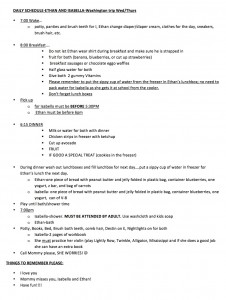In all likelihood you have heard the saying, “Insanity is doing the same thing over and over again but expecting different results.” If this were the true definition of insanity then most of us would fit the bill. Thankfully this is not the case. Nonetheless, it is astounding how many people use the same flawed approach every time anticipating that things will turn out differently.
For some this means continuing to try to motivate your team with sales quotas and salary increases even though they never have been incentivized by this type of financial data. For others it means attempting to use innovation and vision as your product’s selling points when all your client cares about is compliance with government regulations and functionality. For a dear friend of mine, it means leaving her mother-in-law with a “daily schedule” (like the one above) hoping that this time Grandma gets it right.
Given that the demands on our already limited time only are increasing, I imagine you may be at the place where having the same conversation over and over again finally has lost its appeal. Perhaps you can see for the first time that your “bend them to my will” approach isn’t getting you the results you want. While it takes practice and discipline, there is a highly effective way to break the “Try, Fail, Expletive, Try Again” cycle. The answer, which isn’t sexy but is surprisingly fun, is “Whole Brain Thinking.”
By employing your entire brain, as opposed to part of your brain, you increase your chances of getting what you want whether it be closing a deal, motivating your team, or keeping your organization one step ahead. Although it sounds abstract, technical and perhaps even unobtainable, Whole Brain Thinking is actually easy to understand, intuitive, and can be readily applied.
It simply refers to using all four dimensions of your brain instead of just one when interacting with others in any capacity such as a sales professional, group leader, or C-suite executive. To explain further, each of us has a lens through which we see the world, approach problems, and communicate with others. The following four lenses are available to each of us, but we prefer one over all of the others:
The first lens is the Realist/Analyst; we refer to people in this category as L1s. If you find yourself asking, “What?” or even “What’s the bottom line?” when listening to a story or analyzing a problem you probably belong here. L1s gravitate towards data and salient facts. They are results oriented.
The next group is the Strategist/Imagineer or the R1s. I talked about these guys in my previous post, “What Are Your Chances of Survival?” R1s are the “Why” thinkers. You know you are with an R1 when at the end of the conversation you want to scream, “Because I said so!” R1s are all about the vision, the big picture, generating ideas. They are future oriented.
Now we come to the Empathizer/Socializer, the R2s. I think their name says it all. However, in the event it does not, they are focused on connecting with people and their question is “Who?” They are people oriented.
Lastly, we have the Organizers/Preservers, the L2s. Remember the “daily schedule”? It was most certainly drafted by an L2. L2s enjoy tasks, details, plans and checklists. They are the R1s polar opposite. Where R1s like risk and being outside the box, L2s like structure. They are process oriented.
If you are having difficulty figuring it out, perhaps this illustration will be helpful. Four people get together to discuss throwing a party. The R1 was the one who had the idea in the first place – “I know there is no real reason to do it, but let’s have a party anyway.” The L1 is going to figure out whether having the party is feasible – “Tax season just ended. Is this a good time to have a party? Let’s list out the pros and cons and run some numbers.” Assuming the L1 gives the party the green light, the L2 is going to make it happen – “First I need to book the room and then I need to secure the band, but first I should really research which band is best. Also, we need to mail invites about two weeks in advance and create a spreadsheet to track the RSVPs.” (Meanwhile, at this point, the R1 is still thinking about the party’s theme.) Finally, the R2 is in charge of the guest list – “If we invite Ann we have to invite John too. And, Bob cannot sit next to Sally because they had that argument three weeks ago. I really hope Samantha comes. The party just wouldn’t be the same without her.”
It is important to figure out where you fall. By doing so, you can maximize your strengths and compensate for your blind spots. You can also aim to approach the party more holistically instead of focusing on one aspect to the detriment of others. Imagine an R1 planning the party on her own. It would be the most innovative, cutting edge, creative party ever, but no one would be there because an R1 would never even have considered a guest list.
Another way to think of it is like this – your brain is a car. A car has tires, a gas pedal, a steering wheel, and an ignition. A car with an ignition, but no tires can start but it cannot go anywhere. A car with tires, but no steering wheel moves forward aimlessly. The key to driving a car is to use all four components. The same can be said of your brain. A person who is focused on data, but ignores people can’t see the whole issue. A person who is zeroed in on details, but doesn’t know how it all comes together is never going to get anywhere. Science tells us that people in leadership positions, people at executive levels have figured out how to use their whole brain. The result is flexible, adaptable and versatile executives.
The alternative is to stick with what you know. Keep trying the “my way or the highway” approach to professional success. If you do so, you are all but guaranteed more of the same. You may as well resolve yourself to having a career filled with wasted time, frustration, and achieving less than what is expected of you – less than what you want. If you are willing to accept that, then maybe you are insane after all.

